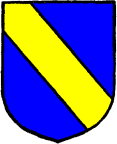
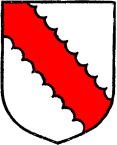
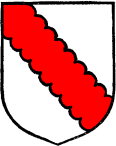
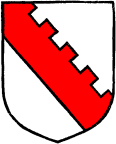
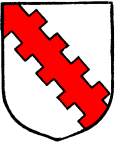
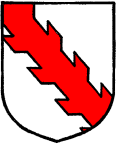
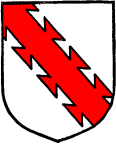
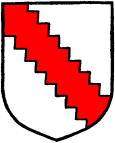
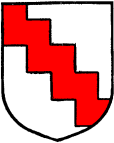

 and the old writers almost universally take them to be derived from the actual military scarf or a representation of it placed across the shield in various forms. Other writers, taking the surcoat and its decoration as the real origin of coats of arms, derive the ordinaries from the belt, scarf, and other articles of raiment. Planché, on the other hand, scouted
such a derivation, putting forward upon very good and plausible grounds the simple argument that the origin of the ordinaries is to be found in the cross-pieces of wood placed across a shield for strengthening purposes. He instances cases in which shields, apparently charged with ordinaries but really strengthened with cross-pieces, can be taken back to a period long anterior to the existence of regularised armory. But then, on the other hand, shields can be found decorated with animals at an equally early or even an earlier period, and I am inclined myself to push Planché's own argument even farther than he himself took it, and assert unequivocally that the ordinaries had in themselves no particular symbolism and no definable origin whatever beyond that easy method of making some pattern upon a shield which
was to be gained by using straight lines. That they ever had any military meaning, I cannot see the slightest foundation to believe; their suggested and asserted symbolism I totally deny. But when we can find, as Planché did, that shields were strengthened with cross-pieces in various directions, it is quite natural to suppose that these cross-pieces afforded a ready means of decoration in colour, and this would lead a good deal of other decoration to follow similar forms, even in the absence of cross-pieces upon the definite shield itself. The one curious point which rather seems to tell against Planché's theory is that in the earliest "rolls" of arms but a comparatively small proportion of the arms are found to consist of these rectilinear figures, and if the ordinaries really originated in strengthening cross-pieces one would have expected a larger number of such coats of
arms to be found; but at the same time such arms would, in many cases, in themselves be so palpably mere meaningless decoration of cross-pieces upon plain shields, that the resulting design would not carry with it such a compulsory remembrance as would a design, for example, derived from lines which had plainly had no connection with the construction of the shield. Nor could it have any such basis of continuity. Whilst a son would naturally paint a lion upon his shield if his father had done the same, there certainly would not be a similar inducement for a son to follow his father's example where the design upon a shield were no more than different-coloured strengthening pieces, because if these were gilt, for example, the son would naturally be no more inclined to perpetuate a particular form of strengthening for his shield, which might not
need it, than any particular artistic division with which it was involved, so that the absence of arms composed of ordinaries from the early rolls of arms may not amount to so very much. Still further, it may well be concluded that the compilers of early rolls of arms, or the collectors of the details from which early rolls were made at a later date, may have been tempted to ignore, and may have been justified in discarding from their lists of arms, those patterns and designs which palpably were then no more than a meaningless colouring of the strengthening pieces, but which patterns and designs by subsequent continuous usage and perpetuation became accepted later by certain families as the "arms" their ancestors had worn. It is easy to see that such meaningless patterns would have less chance of survival by continuity of usage, and at the same time would require a longer continuity of usage, before attaining to fixity as a definite design.
and the old writers almost universally take them to be derived from the actual military scarf or a representation of it placed across the shield in various forms. Other writers, taking the surcoat and its decoration as the real origin of coats of arms, derive the ordinaries from the belt, scarf, and other articles of raiment. Planché, on the other hand, scouted
such a derivation, putting forward upon very good and plausible grounds the simple argument that the origin of the ordinaries is to be found in the cross-pieces of wood placed across a shield for strengthening purposes. He instances cases in which shields, apparently charged with ordinaries but really strengthened with cross-pieces, can be taken back to a period long anterior to the existence of regularised armory. But then, on the other hand, shields can be found decorated with animals at an equally early or even an earlier period, and I am inclined myself to push Planché's own argument even farther than he himself took it, and assert unequivocally that the ordinaries had in themselves no particular symbolism and no definable origin whatever beyond that easy method of making some pattern upon a shield which
was to be gained by using straight lines. That they ever had any military meaning, I cannot see the slightest foundation to believe; their suggested and asserted symbolism I totally deny. But when we can find, as Planché did, that shields were strengthened with cross-pieces in various directions, it is quite natural to suppose that these cross-pieces afforded a ready means of decoration in colour, and this would lead a good deal of other decoration to follow similar forms, even in the absence of cross-pieces upon the definite shield itself. The one curious point which rather seems to tell against Planché's theory is that in the earliest "rolls" of arms but a comparatively small proportion of the arms are found to consist of these rectilinear figures, and if the ordinaries really originated in strengthening cross-pieces one would have expected a larger number of such coats of
arms to be found; but at the same time such arms would, in many cases, in themselves be so palpably mere meaningless decoration of cross-pieces upon plain shields, that the resulting design would not carry with it such a compulsory remembrance as would a design, for example, derived from lines which had plainly had no connection with the construction of the shield. Nor could it have any such basis of continuity. Whilst a son would naturally paint a lion upon his shield if his father had done the same, there certainly would not be a similar inducement for a son to follow his father's example where the design upon a shield were no more than different-coloured strengthening pieces, because if these were gilt, for example, the son would naturally be no more inclined to perpetuate a particular form of strengthening for his shield, which might not
need it, than any particular artistic division with which it was involved, so that the absence of arms composed of ordinaries from the early rolls of arms may not amount to so very much. Still further, it may well be concluded that the compilers of early rolls of arms, or the collectors of the details from which early rolls were made at a later date, may have been tempted to ignore, and may have been justified in discarding from their lists of arms, those patterns and designs which palpably were then no more than a meaningless colouring of the strengthening pieces, but which patterns and designs by subsequent continuous usage and perpetuation became accepted later by certain families as the "arms" their ancestors had worn. It is easy to see that such meaningless patterns would have less chance of survival by continuity of usage, and at the same time would require a longer continuity of usage, before attaining to fixity as a definite design. |
 |
 |
| FIG. 65.--Bend. | FIG. 66.--Bend engrailed. | FIG. 67.--Bend invecked. |
 |
 |
 |
| FIG. 68.--Bend embattled. | FIG. 69.--Bend embattled counter-embattled. | FIG. 70.--Bend raguly. |
 |
 |
 |
| FIG. 71.--Bend dovetailed. | FIG. 72.--Bend indented. | FIG. 73.--Bend dancetté. |
*1 Armorial bearings of Sir Henry Seymour King, K.C.I.E.: Quarterly, argent and azure, in the second and third quarters a quatrefoil of the first, over all a bend barry of six of the second, charged with a quatrefoil also of the first, and gules.A bend wavy is not very usual, but will be found in the arms of Wallop, De Burton, and Conder. A bend raguly appears in the arms of Strangman.
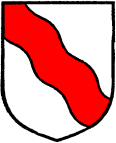 |
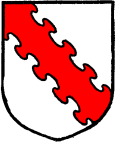 |
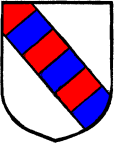 |
| FIG. 74.--Bend wavy. | FIG. 75.--Bend nebuly. | FIG. 76.--Bend compony. |
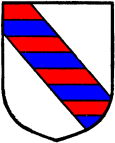 |
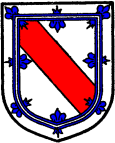 |
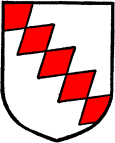 |
| FIG. 77.--Bend barry. | FIG. 78.--Bend within tressure. | FIG. 79.--Bend lozengy. |
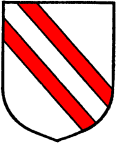 |
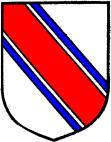 |
| FIG. 80.--Bendlets. | FIG. 81.--Bend cottised. |
*1 Armorial bearings of William Warde-Aldam, Esq.: Quarterly, 1 and 4, party per fesse azure and ermine, in the sinister chief and dexter base an eagle displayed or, in the dexter canton issuant towards the sinister base seven rays, the centre one gold, the others argent(for Aldam); 2 and 3(for Warde).The bend sinister (Fig. 82), is very frequently stated to be the mark of illegitimacy. It certainly has been so used upon some occasions, but these occasions are very few and far between, the charge more frequently made use of being the bendlet or its derivative the baton (Fig. 83). These will be treated more fully in the chapter on the marks of illegitimacy. The bend sinister, which is a band running from the sinister chief corner through the centre of the escutcheon to the dexter base, need not necessarily indicate bastardy. Naturally the popular idea which has originated and become stereotyped concerning it renders its appearance extremely rare, but in at least two cases it occurs without, as far as I am aware, carrying any such meaning. At any rate, in neither case are the coats "bastardised" versions of older arms. These cases are the arms of Shiffner: "Azure, a bend sinister, in chief two estoiles, in like bend or; in base the end and stock of an anchor gold, issuing from waves of the sea proper;" and Burne-Jones: "Azure, on a bend sinister argent, between seven mullets, four in chief and three in base or, three pairs of wings addorsed purpure."
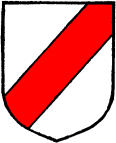 |
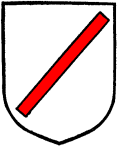 |
| FIG. 82.--Bend sinister. | FIG. 83.--Baton sinister. |

 in this particular coat the ribbon is made "engrailed," which is most unusual, and which does not appear to be the accepted form. In many of the Scottish matriculations of this Abernethy coat in which this riband occurs it is termed a "cost," doubtless another form of the word cottise.
in this particular coat the ribbon is made "engrailed," which is most unusual, and which does not appear to be the accepted form. In many of the Scottish matriculations of this Abernethy coat in which this riband occurs it is termed a "cost," doubtless another form of the word cottise.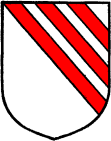 |
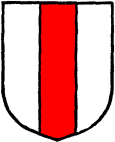 |
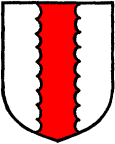 |
| FIG. 84.--Bendlets enhanced. | FIG. 85.--Pale. | FIG. 86.--Pale engrailed. |
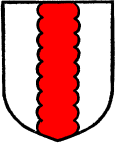 |
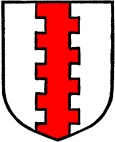 |
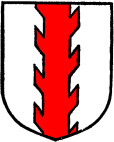 |
| FIG. 87.--Pale invecked. | FIG. 88.--Pale embattled. | FIG. 89.--Pale raguly. |
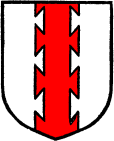 |
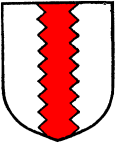 |
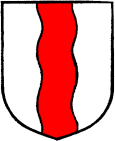 |
| FIG. 90.--Pale dovetailed. | FIG. 91.--Pale indented. | FIG. 92.--Pale wavy. |
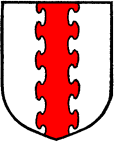 |
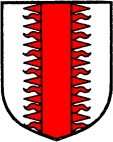 |
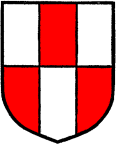 |
| FIG. 93.--Pale nebuly. | FIG. 94.--Pale rayonné. | FIG. 95.--Pale per fesse counter changed. |
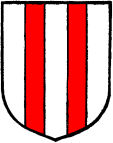 |
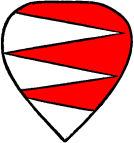 |
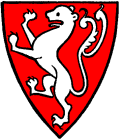 |
| FIG. 96.--Pallets. | FIG. 97.--The arms of Amaury de Montfort, Earl of Gloucester; died before 1214. (From his seal.) | FIG. 98.--Arms of Simon de Montfort, Earl of Leicester; died 1265. (From MS. Cott., Nero, D. I.) |
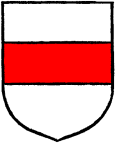 |
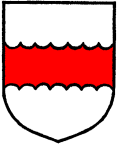 |
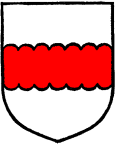 |
| FIG. 99.--Fess. | FIG. 100.--Fess engrailed. | FIG. 101.--Fess invecked. |
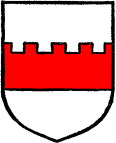 |
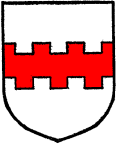 |
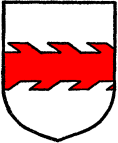 |
| FIG. 102.--Fess embattled. | FIG. 103.--Fess embattled counter-embattled. | FIG. 104.--Fess raguly. |
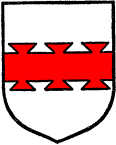 |
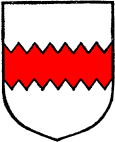 |
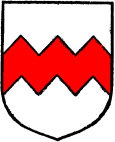 |
| FIG. 105.--Fess dovetailed. | FIG. 106.--Fess indented. | FIG. 107.--Fess dancetté. |
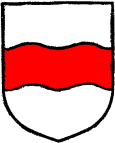 |
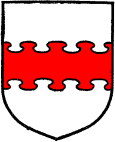 |
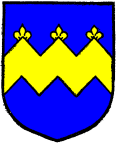 |
| FIG. 108.--Fess wavy. | FIG. 109.--Fess nebuly. | FIG. 110.--The arms of Plowden. |
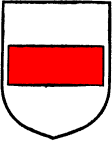 |
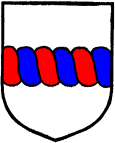 |
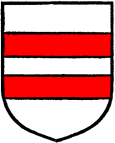 |
| FIG. 111.--Fess couped. | FIG. 112.--Fess wreathed. | FIG. 113.--Two Bars. |
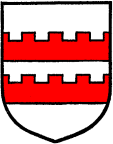 |
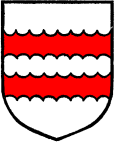 |
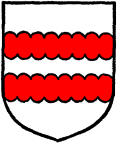 |
| FIG. 114.--Bars embattled. | FIG. 115.--Bats engrailed. | FIG. 116.--Bars invecked. |
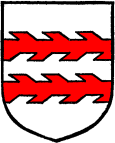 |
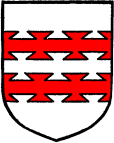 |
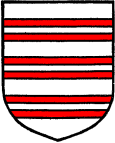 |
| FIG. 117.--Bars raguly. | FIG. 118.--Bars dovetailed. | FIG. 119.--Bars gemel. |
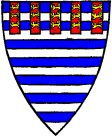 |
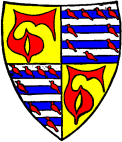 |
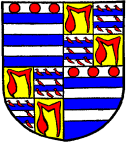 |
| FIG. 120.--Arms of William de Valence, Earl of Pembroke (d. 1296); Barruly azure and argent, a label of five points gules, the files depending from the chief line of the shield, and each file charged with three lions passant guardant or. (From MS. Reg. 14, C. vii.) | FIG. 121.--Arms of Laurence de Hastings, Earl of Pembroke (d. 1348); Quarterly, 1 and 4, or, a maunch gules (for Hastings); 2 and 3, barruly argent and azure, an orle of martlets (for Valence). (From his seal.) | FIG. 122.--Arms of Edmund Grey, Earl of Kent (d. 1489): Quarterly, 1 and 4, barry of six, argent and azure, in chief three torteaux (for Grey); 2 and 3, Hastings and Valence sub-quarterly. (From his seal, 1442.) |
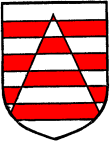 |
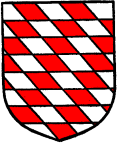 |
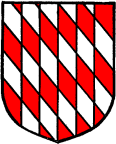 |
| FIG. 123.--Barry, per chevron counter-changed. | FIG. 124.--Barry-bendy. | FIG. 125.--Paly-bendy. |
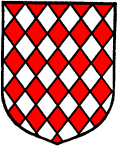 |
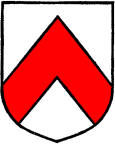 |
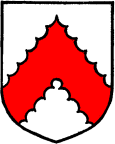 |
| FIG. 126.--Lozengy. | FIG. 127.--Chevron. | FIG. 128.--Chevron engrailed. |
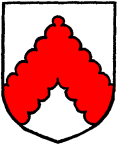 |
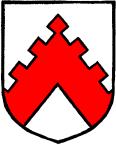 |
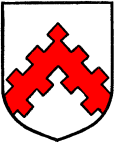 |
| FIG. 129.--Chevron invecked. | FIG. 130.--Chevron embattled. | FIG. 131.--Chevron embattled and counter-embattled. |
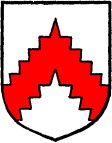 |
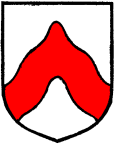 |
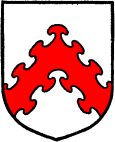 |
| FIG. 132.--Chevron indented. | FIG. 133.--Chevron wavy. | FIG. 134.--Chevron nebuly. |
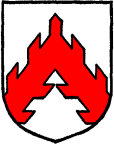 |
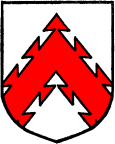 |
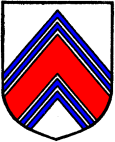 |
| FIG. 135.--Chevron raguly. | FIG. 136.--Chevron dovetailed. | FIG. 137.--Chevron doubly cottised. |
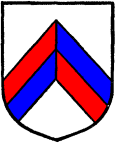 |
| FIG. 138.--Chevron quarterly. |
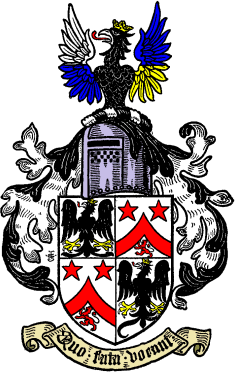 |
| FIG. 139.--Armorial bearings of Rodolph Ladeveze Adlercron, Esq.: Quarterly, 1 and 4, argent, an eagle displayed, wings inverted sable, langued gules, membered and ducally crowned or (for Adlercron): 2 and 3, argent, a chevron in point embowed between in chief two mullets and in base a lion rampant all gules (for Trapaud). Mantling sable and argent. Crest: on a wreath of the colours, a demi-eagle displayed sable, langued gules, ducally crowned or, the dexter wing per fess argent and azure, the sinister per fess of the last and or. Motto: "Quo fata vocant." |
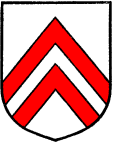 |
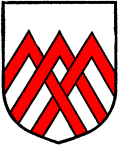 |
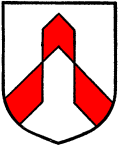 |
| FIG. 140.--Chevronels. | FIG. 141.--Chevronels braced. | FIG. 142.--Chevron rompu. |
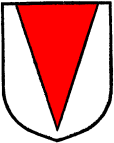 |
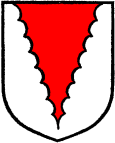 |
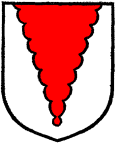 |
| FIG. 143.--Pile. | FIG. 144.--Pile engrailed. | FIG. 145.--Pile invecked. |
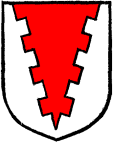 |
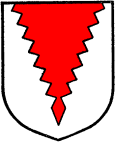 |
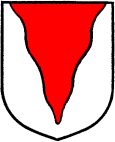 |
| FIG. 146.--Pile embattled. | FIG. 147.--Pile indented. | FIG. 148.--Pile wavy. |
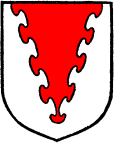 |
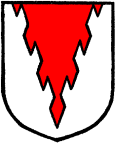 |
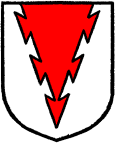 |
| FIG. 149.--Pile nebuly. | FIG. 150.--Pile raguly. | FIG. 151.--Pile dovetailed. |
*1 Armorial bearings of Isham: Gules, a fesse wavy, and in chief three piles in point also wavy, the points meeting in fesse argent.A disposition of three piles which will very frequently be found in modern British heraldry is two issuing in chief and one in base(Fig. 152).
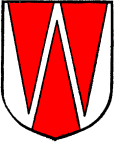 |
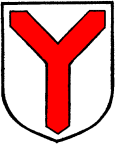 |
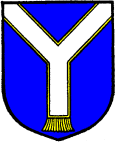 |
| FIG. 152.--Three piles, two in chief and one in base. | FIG. 153.--Shakefork. | FIG. 154.--Ecclesiastical pallium. |
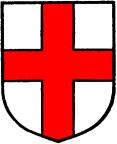 |
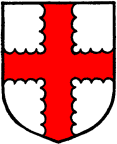 |
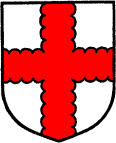 |
| FIG. 155.--Cross. | FIG. 156.--Cross engrailed. | FIG. 157.--Cross invecked. |
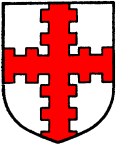 |
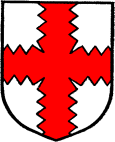 |
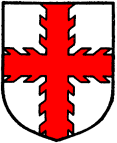 |
| FIG. 158.--Cross embattled. | FIG. 159.--Cross indented. | FIG. 160.--Cross raguly. |
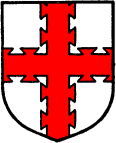 |
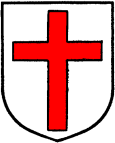 |
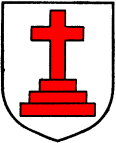 |
| FIG. 161.--Cross dovetailed. | FIG. 162.--Passion Cross. | FIG. 163.--Cross Calvary. |
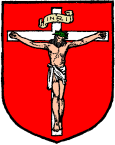 |
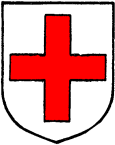 |
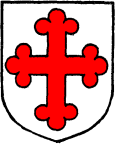 |
| FIG. 164.--Crucifix. | FIG. 165.--Cross couped. | FIG. 166.--Cross botonny. |
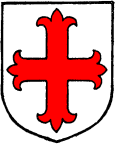 |
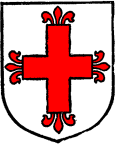 |
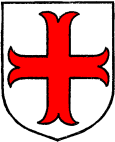 |
| FIG. 167.--Cross flory. | FIG. 168.--Cross fleuretté. | FIG. 169.--Cross moline. |
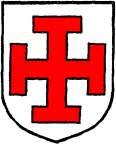 |
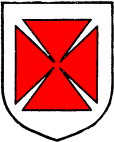 |
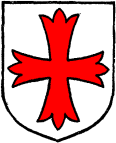 |
| FIG. 170.--Cross potent. | FIG. 171.--Cross patée (or formée). | FIG. 172.--Cross patonce. |
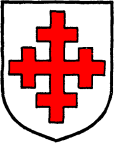 |
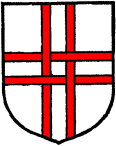 |
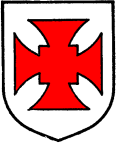 |
| FIG. 173.--Cross crosslet. | FIG. 174.--Cross parted and fretty. | FIG. 175.--Cross patée quadrate. |
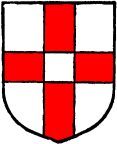 |
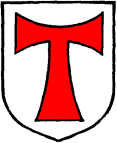 |
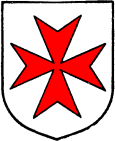 |
| FIG. 176.--Cross quarter-pierced. | FIG. 177.--Cross Tau. | FIG. 178.--Maltese Cross. |
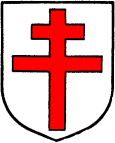 |
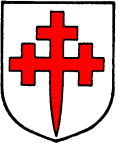 |
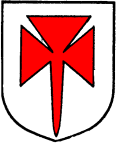 |
| FIG. 179.--Patriarchal Cross. | FIG. 180.--Cross crosslet filched. | FIG. 181.--Cross patée fitched. |
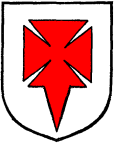 |
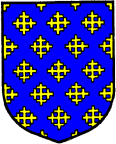 |
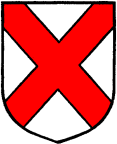 |
| FIG. 182.--Cross patée fitched at foot. | FIG. 183.--Crusilly. | FIG. 184.--Saltire. |
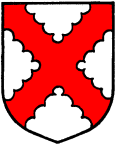 |
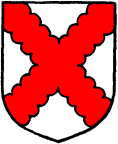 |
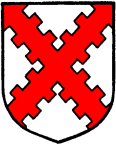 |
| FIG. 185.--Saltire engrailed. | FIG. 186.--Saltire invecked. | FIG. 187.--Saltire embattled. |
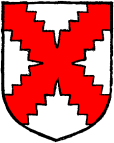 |
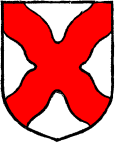 |
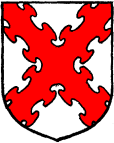 |
| FIG. 188.--Saltire indented. | FIG. 189.--Saltire wavy. | FIG. 190.--Saltire nebuly. |
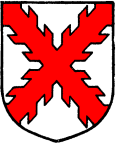 |
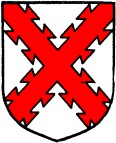 |
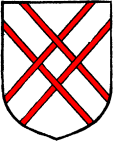 |
| FIG. 191.--Saltire raguly. | FIG. 192.--Saltire dovetailed. | FIG. 193.--Saltire parted and fretty. |
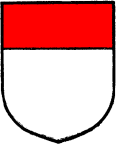 |
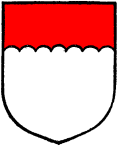 |
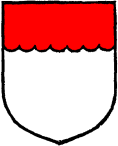 |
| FIG. 194.--Chief. | FIG. 195.--Chief engrailed. | FIG. 196.--Chief invecked. |
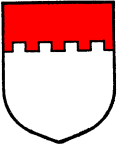 |
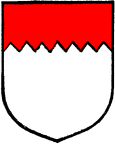 |
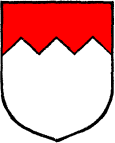 |
| FIG. 197.--Chief embattled. | FIG. 198.--Chief indented. | FIG. 199.--Chief dancetté. |
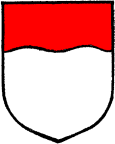 |
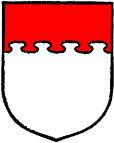 |
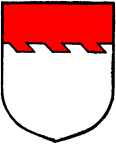 |
| FIG. 200.--Chief wavy. | FIG. 201.--Chief nebuly. | FIG. 202.--Chief raguly. |
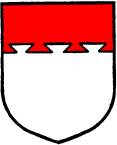 |
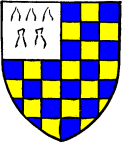 |
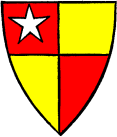 |
| FIG. 203.--Chief dovetailed. | FIG. 204.--Arms of Peter de Dreux, Earl of Richmond (c. 1230): Chequy or and azure, a quarter ermine. (From his seal. | FIG. 205.--Arms of De Vere, Earls of Oxford: Quarterly gules and or, in the first quarter a mullet argent. |
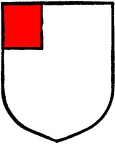 |
| FIG. 206.--Canton. |
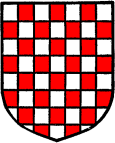 |
| FIG. 207.--Chequy. |
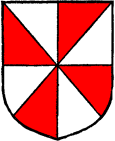 |
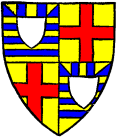 |
| FIG. 208.--Gyronny. | FIG. 209.--The arms of Roger Mortimer, Earl of March and Ulster(d. 1398): Quarterly, 1, 4, azure, three bars or (sometimes but not so correctly quoted barry of six), on a chief of the first two pallets between two base esquires of the second, over all an inescutcheon argent (for Mortimer); 2 and 3, or, a cross gules (for Ulster). (From his seal.) |
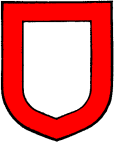 |
| FIG. 210.--Bordure. |
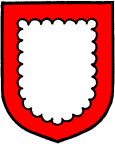 |
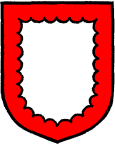 |
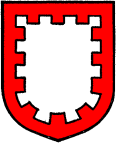 |
| FIG. 211.--Bordure engrailed. | FIG. 212.--Bordure invecked. | FIG. 213.--Bordure embattled. |
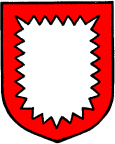 |
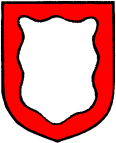 |
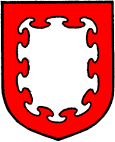 |
| FIG. 214.--Bordure indented. | FIG. 215.--Bordure wavy. | FIG. 216.--Bordure nebuly. |
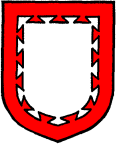 |
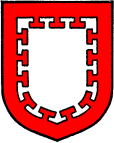 |
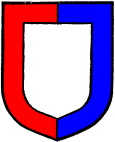 |
| FIG. 217.--Bordure dovetailed. | FIG. 218.--Bordure potenté. | FIG. 219.--Bordure per pale. |
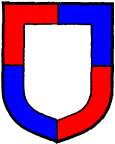 |
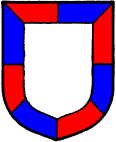 |
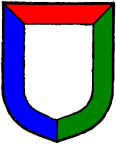 |
| FIG. 220.--Bordure quarterly. | FIG. 221.--Bordure gyronny. | FIG. 222.--Bordure tierced in pairle. |
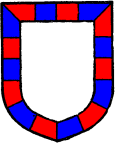 |
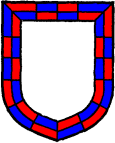 |
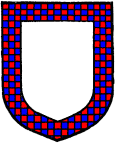 |
| FIG. 223.--Bordure compony. | FIG. 224.--Bordure counter compony. | FIG. 225.--Bordure chequy. |
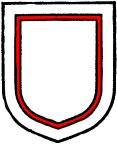 |
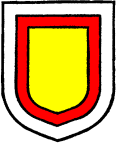 |
| FIG. 226.--Orle. | FIG. 227.--An inescutcheon within a bordure. |
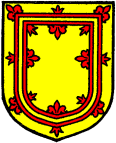 |
| FIG. 228.--Tressure flory and counter-flory. |


*1 Collectanea, ed. 1774, ii. 611.

 a beautiful MS. in the Royal Library at Brussels, the Scottish shields in which have been figured by Mr. Stodart in his book on Scottish arms, and, more accurately, by Sir Archibald Dunbar in a paper read to the Society of Antiquaries of Scotland in 1890. The armorial is believed to be the work of Claes Heynen, Gelre Herald to the Duke of Gueldres between 1334 and 1372, with later additions by another hand. The coat assigned in it to the King of Scotland is the lion and double tressure; the lion is uncrowned, and is armed and langued azure; above the shield is a helmet argent adorned behind with a short capelin or plain mantling, on which is emblazoned the saltire and chief of the Bruces, from which we may gather that the arms of David II. are here represented; the lining is blue, which is unusual, as mantlings are usually lined or doubled with a metal, if not with ermine. The helmet is surmounted by an Imperial crown, with a dark green bonnet spotted with red. *1 On the crown there is the crest of a lion sejant guardant gules, imperially crowned or, holding in his paw a sword upright; the tail is coué or placed between the hind-legs of the lion, but it then rises up and flourishes high above his back in a sufficiently defiant fashion. This shows that the Scottish arms were well known on the Continent of Europe nearly a hundred years before the date of the Grünenberg MS., while Virgil de Solis(c. 1555) gives a sufficiently accurate representation of the Royal shield, though the fleur-de-lis all project outwards as in the case of Grunenberg; he gives the crest as a lion rampant holding a sword in bend over his shoulder. Another ancient representation of the Scottish arms occurs in a MS. treatise on heraldry of the sixteenth century, containing the coats of some foreign sovereigns and other personages, bound up with a Scottish armorial, probably by David Lindsay, Lyon in 1568."
a beautiful MS. in the Royal Library at Brussels, the Scottish shields in which have been figured by Mr. Stodart in his book on Scottish arms, and, more accurately, by Sir Archibald Dunbar in a paper read to the Society of Antiquaries of Scotland in 1890. The armorial is believed to be the work of Claes Heynen, Gelre Herald to the Duke of Gueldres between 1334 and 1372, with later additions by another hand. The coat assigned in it to the King of Scotland is the lion and double tressure; the lion is uncrowned, and is armed and langued azure; above the shield is a helmet argent adorned behind with a short capelin or plain mantling, on which is emblazoned the saltire and chief of the Bruces, from which we may gather that the arms of David II. are here represented; the lining is blue, which is unusual, as mantlings are usually lined or doubled with a metal, if not with ermine. The helmet is surmounted by an Imperial crown, with a dark green bonnet spotted with red. *1 On the crown there is the crest of a lion sejant guardant gules, imperially crowned or, holding in his paw a sword upright; the tail is coué or placed between the hind-legs of the lion, but it then rises up and flourishes high above his back in a sufficiently defiant fashion. This shows that the Scottish arms were well known on the Continent of Europe nearly a hundred years before the date of the Grünenberg MS., while Virgil de Solis(c. 1555) gives a sufficiently accurate representation of the Royal shield, though the fleur-de-lis all project outwards as in the case of Grunenberg; he gives the crest as a lion rampant holding a sword in bend over his shoulder. Another ancient representation of the Scottish arms occurs in a MS. treatise on heraldry of the sixteenth century, containing the coats of some foreign sovereigns and other personages, bound up with a Scottish armorial, probably by David Lindsay, Lyon in 1568."*1 In M. Victor Bouton's edition of the Armorial de Gelre (Paris 1881) the bonnet is described as a mount.The tressure, like the bordure, in the case of an impalement stops at the line of impalement, as will be seen by a reference to the arms of Queen Anne after the union of the crowns of England and Scotland.

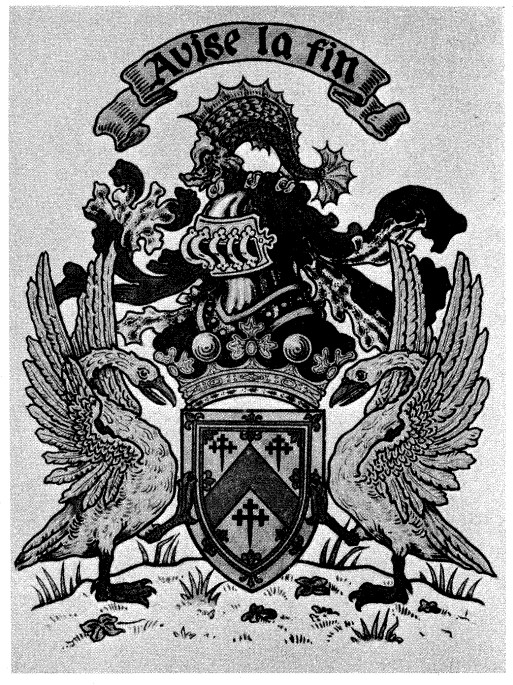 |
| FIG. 229.--Armorial bearings of Sir Archibald Kennedy, Marquess of Ailsa: Argent, a chevron gules between three cross crosslets fitchée sable, all within a double tressure flory and counter-flory of the second. Mantling gules, doubled ermine. Crest: upon a wreath of his liveries, a dolphin naiant proper. Supporters: two swans proper, beaked and membered gules. Motto: "Avise la fin." (From the painting by Mr.Graham Johnston in the Lyon Register. |
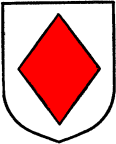 |
| FIG. 230.--Lozenge. |
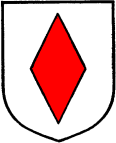 |
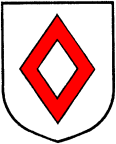 |
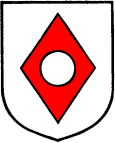 |
| FIG. 231.--Fusil. | FIG. 232.--Mascle. | FIG. 233.--Rustre. |
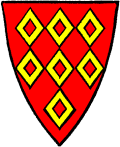 |
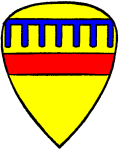 |
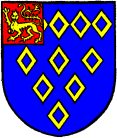 |
| FIG. 234.--Arms of Roger de Quincy, Earl of Winchester (d. 1264): Gules, seven mascles conjoined, three, three and one or. (From his seal.) | FIG. 235.--Arms of Seiher de Quincy, Earl of Winchester (d. 1219): Or, a fess gules, a label of seven points azure. (From his seal. | FIG. 236.--Arms of Louis de Bruges, Earl of Winchester (d. 1492. |

 "Masclee de vere and de goules," but whether the
inference is that this blazon is wrong or that lozenge and mascle were identical terms I am not aware.
"Masclee de vere and de goules," but whether the
inference is that this blazon is wrong or that lozenge and mascle were identical terms I am not aware.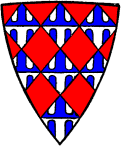 |
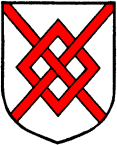 |
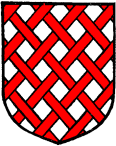 |
| FIG. 237.--Arms of Hubert de Burgh, Earl of Kent (d. 1243). (From his seal.) | FIG. 238.--The Fret. | FIG. 239.--Fretty. |
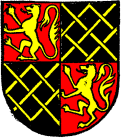 |
| FIG. 240.--Arms of John Fitz Alan, Earl of Arundel (d. 1435): Quarterly, 1 and 4, gules, a lion rampant or (for Fitz Alan); 2 and 3, sable, fretty or (for Maltravers). (From his seal, c. 1432.) |
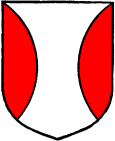 |
| FIG. 241.--Flaunches. |
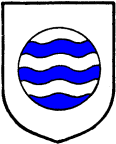 |
| FIG. 242.--Fountain. |
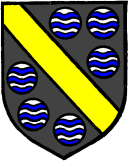 |
| FIG. 243.--The Arms of Stourton. |

 says the same thing: "These six Fountains are borne in signification of six Springs, whereof the River of Sture in Wiltshire hath his beginning, and passeth along to Sturton, the seat of that Barony." Here, then, is the origin of the six fountains upon the coat of arms; but Aubrey remarks that three of the six springs in the park are in the county of Wilts, whereas Mr. Camden has put them all in Somersetshire. However, the fact is that three of the springs were inside the park and three outside, and that three were in
Wiltshire and three in Somersetshire. Here, then, is to be found the division upon the coat of arms of the six fountains in the two sets of three each, and it is by no means an improbable suggestion that the bend which separates the three from the three is typical of, or was suggested by, either the park wall or pale, or by the line of division between the two counties, and the more probable of the two seems to be the park wall. The coat of arms is just a map of the property. Now, with regard to the arms, as far as is known there has not been at any time the slightest deviation by the family of the Lords Stourton from the coat quoted and illustrated. But before leaving the subject it may be well to point out that in the few cases in which an ancient coat of arms carries with it an explanation, such explanation is usually to be found either in some such manner as that in which these arms of Stourton have
been explained, or else in some palpable pun, and not in the mythical accounts and legends of supernatural occurrences which have been handed down, and seldom indeed in any explanation of personal nobility which the tinctures or charges are sometimes said to represent.
says the same thing: "These six Fountains are borne in signification of six Springs, whereof the River of Sture in Wiltshire hath his beginning, and passeth along to Sturton, the seat of that Barony." Here, then, is the origin of the six fountains upon the coat of arms; but Aubrey remarks that three of the six springs in the park are in the county of Wilts, whereas Mr. Camden has put them all in Somersetshire. However, the fact is that three of the springs were inside the park and three outside, and that three were in
Wiltshire and three in Somersetshire. Here, then, is to be found the division upon the coat of arms of the six fountains in the two sets of three each, and it is by no means an improbable suggestion that the bend which separates the three from the three is typical of, or was suggested by, either the park wall or pale, or by the line of division between the two counties, and the more probable of the two seems to be the park wall. The coat of arms is just a map of the property. Now, with regard to the arms, as far as is known there has not been at any time the slightest deviation by the family of the Lords Stourton from the coat quoted and illustrated. But before leaving the subject it may be well to point out that in the few cases in which an ancient coat of arms carries with it an explanation, such explanation is usually to be found either in some such manner as that in which these arms of Stourton have
been explained, or else in some palpable pun, and not in the mythical accounts and legends of supernatural occurrences which have been handed down, and seldom indeed in any explanation of personal nobility which the tinctures or charges are sometimes said to represent.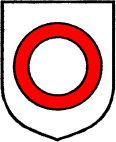 |
| FIG. 244.--Annulet. |
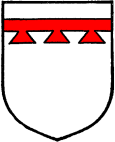 |
| FIG. 245.--The Label. |
"... a label of four points in bend sinister... Wm. de Curli, 20th Hen. III. (Cotton, Julius F., vii. 175.)A curious label will have been noticed in the arms of De Valence(Fig. 120).
"Argent, a label of five points azure. Henlington, co. Gloucester. (Harl. MS. 1404, fo. 109.)
"Or, a file gules, with three bells pendent azure, clappers sable. (Belfile.)
"Sable, three crescents, in chief a label of two drops and in fess another of one drop argent. Fitz-Simons. (Harl. MS. 1441 and 5866.)
"Or, three files borne barways gules, the first having five points, the second four, and the last three. Liskirke, Holland. (Gwillim.)"
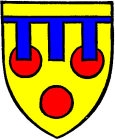 |
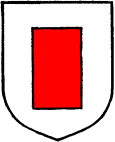 |
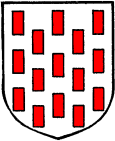 |
| FIG. 246.--Arms of Hugh Courtenay, Earl of Devon (d. 1422): Or, three torteaux, a label azure. (From his seal. | FIG. 247.--The Billet. | FIG. 248.--Billetté. |
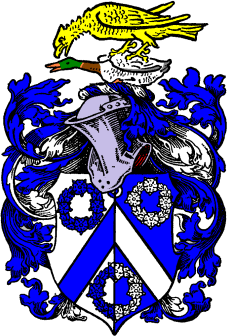 |
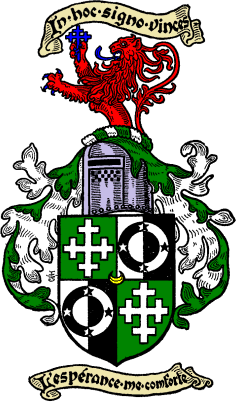 |
| FIG. 249.--Armorial bearings of R. E. Yerburgh, Esq.: Per pale argent and azure, on a chevron between three chaplets all counterchanged, an annulet for difference. Mantling azure and argent. Crest: on a wreath of the colours, a falcon close or, belled of the last, preying upon a mallard proper. | FIG. 250.--Armorial bearings of Robert Berry, Esq.: Quarterly, 1 and 4, vert, a cross crosslet argent (for Berry); 2 and 3, parted per pale argent and sable, on a chaplet four mullets counterchanged (for Nairne), in the centre of the quarters a crescent or, for difference. Mantling vert, doubled argent. Crest: upon a wreath of his liveries, a demi-lion rampant gules, armed and langued, holding in his dexter paw a cross crosslet fitchée azure; and in an escroll over the same this motto, "In hoc signo vinces," and in another under the shield, "L'espérance me comforte." |